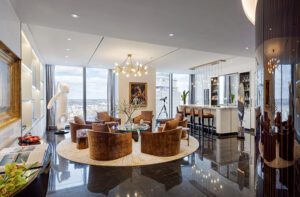Feathering the Empty Nest
October 3, 2016
As her children enter adulthood, a Boston mom creates a home that’s both a launching pad and a welcoming place to land.
Text by Debra Judge Silber Photography by Michael J. Lee
A Boston Townhouse for an Empty Nester
When Nicole Hogarty’s client stands in the center of her Boston townhouse and describes it from end to end, the delight comes through in her voice. She starts in the front, with the armchairs where she takes her morning coffee, then moves into the calm, creamy hues of the living room, where she surprised both her designer and herself by choosing two bright-red, round coffee tables. She moves on to tell a story about the dining room chandelier, which she and Hogarty discovered independently, each knowing instinctively the other would love it.
Looking past the kitchen through the French doors to the back patio, the homeowner sees in her mind’s eye her nearly grown son and daughter, chatting it up with friends in the dappled sunlight.
“I walk around this house, and it just puts a smile on my face,” she says. “I know it’s not exactly true that furnishings dictate how your life is, but this house really represents where we are now.”
Her comment refers not only to the South End home in which she stands, but also the optimistic outlook that it represents. With her children about to set the course for their own lives, she wanted a new home base that would reflect her own sense of empowerment and faith in the future. She wanted a home that would liberate as well as nurture—one that would encourage her kids to take on the world with confidence and draw them back with homey comforts. Accordingly, it would have to be a house that could expand and contract effortlessly, often at a moment’s notice.
She and Hogarty, whose design firm is based in Boston, had collaborated on two homes previously, both times adhering strictly to a traditional style. Not this time. “She wanted to take a much cleaner, more modern approach,” says Hogarty.
She also was determined to have fun—a word the client used frequently to describe the bold geometric wall coverings, colorful artwork, and contemporary fixtures she would never have considered before. “I wanted to make it younger, modern, not what you’d expect,” the homeowner explains. “Really, to have it be a breakout environment for me and the kids.”
Planning began with a pre-purchase visit to the 2,200-square-foot unit comprising three floors of a 1910 brick townhouse in Rutland Square. The main floor, accessed by steps leading up from the street, includes the living, dining, and kitchen areas; bedrooms are downstairs, on street level.
A basement level with a full bath, kitchenette, and family room sits below-grade in front but opens to a private patio in the rear. Large windows in the front and back of the unit, and high ceilings—nearly eleven feet on the main floor and nine feet on the lower floors—make the space bright and open.
The unit’s slender footprint posed a challenge for Hogarty. The main living area, for example, measures less than twelve feet wide, so she knew she’d have to use every space-shifting trick in her book. She started with appropriately scaled furnishings and then worked with manufacturers to tweak the dimensions of key pieces. She widened a Holly Hunt dining table by six inches to allow family-style serving in the limited dining area, and slimmed a Bright Group settee by four inches so the entry door can swing behind it. “Every inch or two mattered,” Hogarty says.
She also considered how each piece might play a dual role, and how each space might be put to a second use. “There wasn’t a design move we did, or a corner or wall space we considered, that we didn’t think of in terms of different purposes,” she says. So armchairs stationed in a niche by the front windows also fill in at the dining table, and a console that doubles as a buffet shelters two upholstered footstools that pull forward as seating.
Adaptability goes into high gear on the lowest level, where a drop-down bed and a strategically placed door transform the family room into a private suite for the twenty-one-year-old son. “Everyone loves it down there,” the homeowner says enthusiastically. “When the bed is put away, it’s a fabulous family room, but with the bed it’s transformed. It’s like a beautiful hotel suite.”
Along with privacy, Hogarty and her client knew that nothing would keep the kids coming back like simple comfort. So the two personally tested every chair. “We made it a point to go to the showrooms and sit in each of the pieces,” Hogarty says. “When you come home, it’s all about being comfortable and being nestled.”
Her client couldn’t agree more. “It’s my hope that when my kids go off, they say, ‘You know, Boston isn’t so bad,’ and they’ll come back,” she says. “And their rooms will be ready for them when they do.” •
Share
![NEH-Logo_Black[1] NEH-Logo_Black[1]](https://b2915716.smushcdn.com/2915716/wp-content/uploads/2022/08/NEH-Logo_Black1-300x162.jpg?lossy=1&strip=1&webp=1)















You must be logged in to post a comment.